
views
X
Trustworthy Source
Mayo Clinic
Educational website from one of the world's leading hospitals
Go to source
You can reduce the amount of belly fat and the risks it poses by losing weight. Make a few dietary and lifestyle changes to help lose weight and support a healthy lifestyle.
Modifying Your Diet to Lose Belly Fat

Talk to your doctor. Speak to your doctor prior to starting any new diet or physical activity plan. They will be able to tell you if your plan is safe and appropriate for you. Typically, excess belly fat is associated with many chronic health conditions like diabetes or heart disease. This makes it even more important to inform your doctor of your plan and make sure it's safe for your specific health conditions.

Eat fewer carbs. Studies have shown that carbohydrate-rich foods can cause an increase in belly fat and waist circumference. Reduce the amount of these foods in your diet to help you lose weight and decrease the amount of belly fat. Your diet should consist of mostly lean proteins, vegetables, fruits, and low-fat dairy. Limit your intake of empty carbohydrates like bread, rice, crackers, or pasta. These foods aren't necessarily unhealthy, especially if they're whole grain foods, but they are not considered nutrient-dense foods. If you're going to eat a carbohydrate-rich food, choose 100% whole grains. These foods are higher in fiber and some nutrients and are considered a healthier choice. Pay attention to portions; one portion of pasta or rice should be half a cup or 50 grams. Whole grain foods include brown rice, 100% whole wheat bread and pasta, barley, or quinoa.
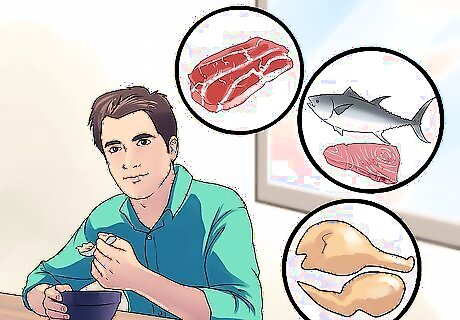
Load up on lean protein. Protein-based foods can help men lose weight, reduce belly fat, and maintain lean muscle mass. Consuming adequate amounts of protein will also help keep you feeling satisfied longer. To lose fat, protein should make up about 20–25% of your daily calories. For instance, if you're eating 1,600 calories a day, you need 80 to 100 grams of protein; if you're eating 1,200 calories a day, you need 60 to 75 grams of protein per day. Lean proteins include lentils, skinless chicken, turkey, eggs, low-fat dairy, seafood, pork, lean beef, and tofu. These provide you with the energy you need and help keep you full without piling on unnecessary calories.

Create a calorie deficit. Lower your total daily calories to help you lose weight. You can do this in several ways. Try cutting down on portion sizes, burning more calories through physical activity, and changing the composition of your diet to higher protein, lower fat, and lower carbohydrates. Begin keeping track of the amount of calories you consume on a daily basis. Don't forget to include the calories in beverages, cooking oils, salad dressings, and sauces. Begin a food journal so that you can track your intake. Online food journals or smartphone apps are designed to help people find the calorie content of the foods they eat, keep track of their intake, and even connect with other dieters. The amount of calories you will need to eat in order to lose weight depends on your age, build, and level of physical activity. To lose 1 to 2 pounds a week, cut out about 500 to 1,000 calories per day. This rate of weight loss is safe and appropriate for most men. EXPERT TIP Laila Ajani Laila Ajani Fitness Trainer Laila Ajani is a Fitness Trainer and founder of Push Personal Fitness, a personal training organization based in the San Francisco Bay Area. With over 10 years as a trainer and exercise specialist, Laila has expertise in competitive athletics (gymnastics, powerlifting, and tennis), personal training, distance running, and Olympic lifting. Laila is certified by the National Strength & Conditioning Association (NSCA), USA Powerlifting (USAPL), and she is a Corrective Exercise Specialist (CES). Laila Ajani Laila Ajani Fitness Trainer Consume fewer calories than you burn. To lose weight, you should control your daily calorie intake to achieve a calorie deficit. For individuals with low activity levels, maintaining a calorie deficit can be achieved by consuming no more than 1,200-1,500 calories for females and 1,400-1,600 calories for males.
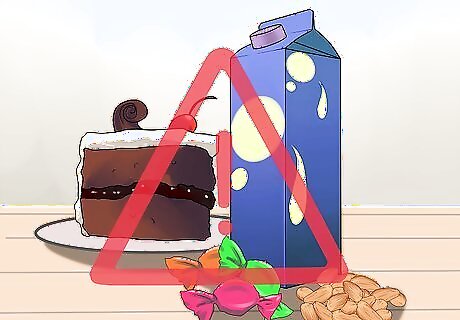
Reduce your intake of sugar. Studies have shown that consumption of sugar can lead to increased belly fat over time. Men who eat less sugar have a smaller waist circumference. Items to limit or discontinue eating include sweetened beverages, candy, cookies, cakes and other sweets, and foods made with white flour (like white bread or plain pasta). If you are craving sweets, try eating a piece of fruit or having a very small serving of your favorite sweet.

Ditch the alcohol. There's a reason why they call it a “beer belly.” But beer is not the only drink that causes increased belly fat. Studies have shown that all types of alcohol can lead to belly fat in males. It's recommended to have no more than two alcoholic beverages daily for men. However, if you want to reduce belly fat, it's recommended to discontinue drinking altogether.
Including Physical Activity to Reduce Belly Fat

Start exercising. Exercise combined with a low-calorie diet will support and speed up weight loss by burning calories and increasing your metabolism. Including regular cardiovascular activity can help you lose weight and decrease your belly fat. Running, hiking, biking, and swimming are all examples of calorie-burning cardio exercises. Aim to get at least 30 minutes of aerobic exercise five times a week for a modest benefit. If you don't want to exercise every day, then find ways to incorporate more movement into your daily routine. Get in the habit of taking the stairs rather than the elevator, parking farther away from your destination, and using a standing desk. It is especially important to exercise if you work a sedentary desk job.
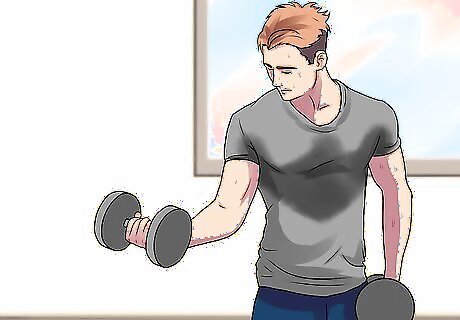
Include regular strength training. As you age, it may be harder to reduce the amount of belly fat. This is partially due to the natural decrease in lean muscle mass as you age, but also because you begin to store more fat around your midsection. Maintaining lean muscle mass can help prevent this. Include at least two days of 20–30 minutes of strength or resistance training each week. Strength training exercises include free weights, weight classes, weight machines, or yoga.
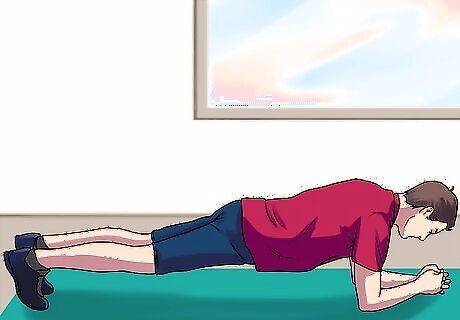
Include whole body exercises. “Spot-training,” or focusing only on exercises like crunches and planks, may help strengthen your core, but does not reduce belly fat. Toning and strength training exercises build lean muscle mass, but don't decrease fat stored around your midsection. Focus on overall weight loss. Modify your diet and include appropriate amounts of cardio. Then begin incorporating abdominal workouts into your routine to tone your midsection.
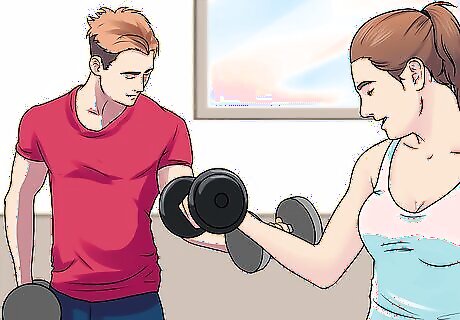
Find an exercise buddy. Having somebody to accompany you on your workouts can make exercise feel more enjoyable. Studies have shown you're more likely to keep a scheduled workout and workout more often if you're going with a friend. If you are a competitive person, it may be fun to race with your weight-loss buddy to see who can reach their goal weight first.
Tracking Progress and Staying Motivated
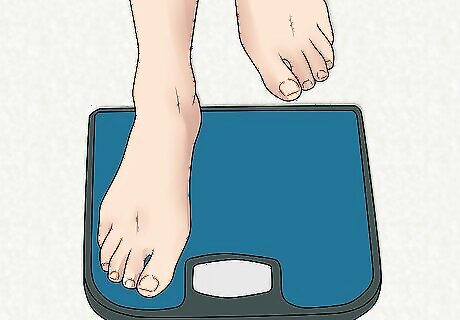
Weigh yourself. To get rid of or reduce belly fat, you'll need to reduce your weight. To help keep track of your weight loss, weigh yourself regularly. It's best to weigh yourself about one to two times a week. In addition, try to weigh yourself on the same day of the week, at the same time and wearing the same clothes. Keep track of your weight in a journal. Seeing your progress can be motivating to help you stay on track. It can also show you any trends where you're gaining weight as well.
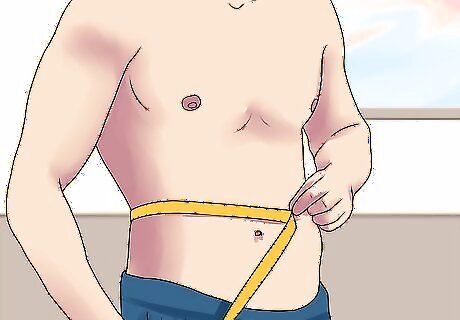
Take measurements. In addition to weight loss, one of the best ways to measure your progress of losing belly fat is to track your waist circumference. This is the measurement around the smallest part of your waist. As you decrease belly fat, your waist circumference will decrease. Use a tape measure to measure the circumference of your waist. Find the top of your hip bone and your lowest rib, then wrap the tape around your belly between these two points. Continue taking measurements as you diet to track your progress. A high waist circumference or a measurement over 37 inches (94 cm) indicates you have a large quantity of belly fat and are at risk for chronic diseases. Remember that muscle weighs more than fat, so if you are trying to lose weight while building muscle, the scale can be misleading. Your best bet is to track your progress by measuring your waistline and weight together.

Make a list of other things to do instead of eating. Dieting can be hard, especially when you find yourself constantly thinking about food or eating out of boredom. The best way to curb your appetite is to stay busy and indulge in activities that you enjoy. Making a list of other activities to engage in can help decrease excess snacking or boredom eating. Have this list handy when the desire to eat strikes. Ideas to try include taking a walk, reading a book, cleaning out a junk drawer, talking to a friend or family member on the phone, or doing household chores. If you're feeling hungry and it's close to a planned meal or snack time, have your meal and then move on with other activities. Do not continue to eat or snack.

Manage stress. When we have chronic stress in our lives, our bodies release the hormone cortisol, which causes the body to store extra fat in the midsection. In addition, chronically elevated cortisol levels can increase hunger levels. Try to eliminate and manage stressful things, people, and situations in your life. Learn how to better manage the stress associated with elements of your life that can't be changed (like your job, for example). Meeting with a life coach or therapist can provide additional ways to manage stress. Remember that while you can't always control your circumstances, you can control the way you react. Mind and body practices like yoga and meditation help you learn how to relax your mind so that you can better cope with stress, anxiety, and depression.

















Comments
0 comment